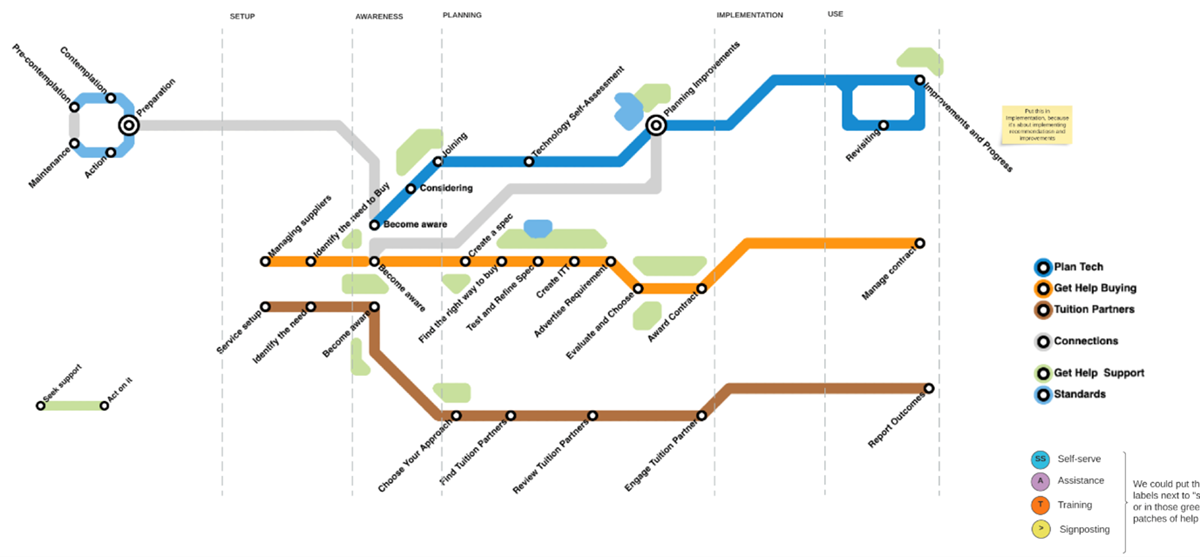Department for Education: Service Design leadership across the schools portfolio
We're working within the Department for Education's National Schools Portfolio, taking a collaborative approach to designing user-centred services.

For the past few years, we’ve been working within the Department for Education’s (DfE) National Schools Portfolio on the Schools Technology Services (STS) programme. Working with both the Senior Leadership Team and within project teams, the work has been a collaborative approach to designing user-centred services, creating a meaningful experience for users.
Building a collaborative bridge
The STS programme and wider portfolio were in their infancy, so as possibilities and challenges emerged, we adapted and responded. These responses were formed both by our expertise and by tapping into organisational knowledge and experience drawing on researchers, sector experts, policy colleagues, and most importantly, the voices of school users themselves. We also identified and used service patterns – sharing great ideas between teams and services to make everyone's work more efficient.
Designing end-to-end user journeys
To design meaningful end-to-end services, we explored where the ends of those services were from the perspective of the people who were going to use them. Understanding the user journey holistically was key.
We collaborated with the DfE to explore how products and services could be combined to create greater value for both schools and the DfE. This work, exemplified by our speculative design project on future service-product associations, meant we could anticipate and prepare for potential policy impacts ahead of time.
While most services have an online, digital element, we also considered other options – perhaps schools would be best served by a training programme or some more direct assistance, or perhaps a cross-channel combination. We also kept in mind that DfE has both internal and external service users. As services became more complex, and touched on different parts of the organisation, this approach meant we kept a range of user experiences in mind.
Visualising complexity
Complexity thrives in service design, and to navigate it effectively, we employed visual storytelling. Service blueprints, landscape maps, and creative adaptations (one of them based on the tube map) became a means to visualise the services that already existed in the portfolio, and show where new services might fit in.

These visual tools fostered communication and engagement amongst team members and stakeholders and were invaluable in inviting feedback, refining designs, and aligning on service direction. Often, the conversations that they enabled were the deliverables.
Strategic tools
We embraced frameworks and impact mapping to evaluate and communicate the success of our co-created services. These allowed us to identify overlaps, potential gaps, and make informed decisions about service development and future iterations. They also provided value to the STS programme as strategic tools, to manage the complexity of an evolving service offering. We used design histories throughout the project to manage knowledge and share understanding.
Speculative design
Thinking ahead to consider the future is an important part of Service Design. We facilitated and led workshops to understand the possible repercussions of future policy changes and what those outcomes would mean for existing products and services. This led to collaborative ideation sessions with wide-ranging ideas that had not been previously considered.
The outcome of these sessions was a conclusion that the current products and services needed to be more closely associated to each other to provide a holistic experience for users, and that a wider range of non-digital solutions would need to be considered longer term. The workshops were a key input into policy decision-making.
Prototyping
We created simple digital prototypes in the UCD Policy Lab – a team of people focused on approaching key policy questions using UCD practices – as a way of conducting research through design. The prototypes are used to engage a target audience and explore their responses.
Conversely, the prototypes we developed for the ‘Plan Technology for your School’ service were about refining a digital interface and interactions, to increase certainty and inform subsequent development. These were built using the GDS prototype kit, to make them as realistic as possible.
We also prototyped the deeper aspects of services, such as business or financial processes. This was especially important for the upcoming Acquiring Tech alpha, where we needed to understand how the service might work within DfE, behind the scenes. The way we employed and tested these prototypes allowed us to gather feedback to inform the design.
Content is key
We worked on the production of DfE's Digital Standards, now published. This content design work is guided by and feeds into the Government Digital Service (GDS) style guide. We also developed guidance on how to produce and write those standards, and how to work with SMEs to capture key information.
Furthermore, we introduced and continue to build on a robust and reliable review process, which includes comprehensibility testing of the content itself, to ensure we’re using plain English. This means that DfE can be as confident as possible that staff in schools will understand these Digital Standards.
Design histories for the Digital Standards are available to view at:
- Reviewing the format and content of our standards (education.gov.uk)
- What makes a standard...a standard? (education.gov.uk)
Integration and collaboration as a key to success
The success of our work with DfE hinged on strong, multi-disciplinary teams. We recognised the value of diverse perspectives and actively fostered integration across disciplines. Structured project inceptions ensured teams gelled effectively, while collaborative artefacts like the Target Model (a joint effort between DfE subject matter experts, user researchers, service designers, data analysts, and content designers) acted as boundary objects, bridging the gap between roles and facilitating shared understanding.
The UCD Policy Lab exemplified our commitment to integration, bringing our UCD practitioners together with DfE's policy colleagues to co-create solutions that meet both policy goals and user needs. An example of this work is the STS Plan Technology service, currently in BETA testing, which helps schools evaluate the technology they use and provides them recommendations to develop it further. The development and launch of the Digital Standards and the ongoing work to join these up with Plan Technology also illustrate the value of such a collaborative approach.
Looking forward
Our service design journey with DfE is ongoing, but the foundation we've built on user focus, prototyping, and multi-disciplinary collaboration is paving the way for meaningful service delivery in the National Schools portfolio. By continually building bridges between policy intent and service outcomes, we are empowering schools and navigating challenges together.

Get in touch
Please email shaun.gomm@nexergroup.com if you would like to discuss our work, or call our Macclesfield office on +44 (0)1625 427718
